Art & Architecture
 |
 |
 |
 |
 |
 |
 |
Analyzing Van Eyck's Mystical Lamb

Recently TIA received an inquiry about a painting titled The Adoration of the Mystic Lamb. A reader had inherited a print of this art work, which is part of the famous 24-panel Ghent Altarpiece painted by Jan van Eyck in 1432 for St. Bavo's Cathedral in Ghent. (See the reproduction of the full altar painting at the end of this article.)
Our reader was concerned that there might be something objectionable about this painting since she had heard that many Renaissance artists used occult or gnostic symbols in their works.
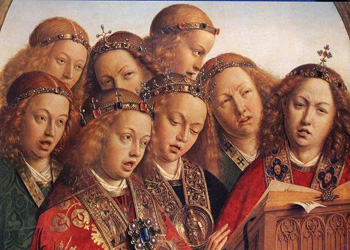
One sees the rich detail of Van Eyck in the Angels panel on the Ghent Altarpiece
It is my opinion that the 15th century Flemish School of Painting – Jan van Eyck is one of its important masters – still represented much of the spirit of the Middle Ages. This follows the opinion of other art analysts who point out that painting schools take longer than other arts to reflect the influences of their times.
At any rate, it would appear that the Flemish painters of that time were much less affected by the Italian Renaissance. It was only in the early 16th century that this influence became more notable.
Jan van Eyck became known for his exquisite detail, material splendor, brilliant coloring, naturalistic rendering of reality, and heavy use of symbolism - all present in this monumental piece. The central altarpiece scene of the Mystic Lamb is so filled with figures and objects that it can certainly appear confused to the modern eye. It would not be surprising for a man of our century to have suspicions: "What is going on here? Is this some cult to nature?"
No, not at all. The artist had a meaning for each part of this scene, as well as the whole altarpiece. He intended to express a rich Catholic symbolism of the redemptive mysteries of the Catholic Faith.
The Lamb of God
In the center of the painting is the Lamb bleeding into a golden chalice, a symbol of Our Lord Jesus Christ in the Holy Eucharist. The Lamb is Christ Who shed His Blood on Calvary and in a bloodless way renews His sacrifice daily on the altar.
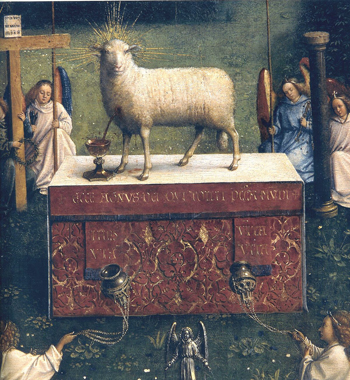
The Lamb of God bleeds into the chalice on the altar as a renewal of His sacrifice on Calvary
Jan van Eyck, as if in response to these pseudo-reformers condemned by the Council of Constance in 1415, represented the Catholic teaching on the centerpiece of his grandiose work: Our Lord Jesus Christ, The Lamb of God, is present on every altar in the Holy Sacrifice of the Mass.
"Salvation belongs to our God who is seated on the throne, and to the Lamb" (Apoc 7:10). The Mystical Lamb, His sacrifice complete, no longer feels pain. His contemplative, unearthly gaze has a divine air. His Blood flows from his chest into a chalice, a symbol of its redemptive value. Our Lord shed every drop of His Blood to save mankind from eternal death; not a drop was wasted. This is the heart of the Ghent Altarpiece.
The four-part procession
This Lamb on the altar contemplates us, as if inviting us to join the four-part procession taking place on that canvas.
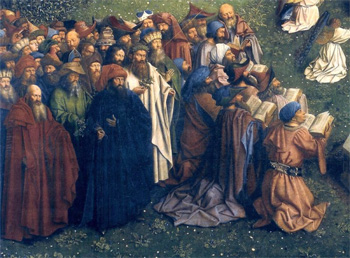
Prophets and pagans represent the Old Testament anticipation of Christ
The figure in white holding a laurel wreath is generally held to be Virgil, who predicted the coming of the Savior in his Fourth Eclogue. Isaiah stands to his side holding a twig, a symbol of his own prophecy of the Redeemer (Is 11:1).
In the group on the right, we find New Testament representatives, the 12 Apostles dressed in red, symbolizing their martyrdom. Behind them are Popes, Bishops and clergy. Three of the figures in the grouping to the right represent the Western Schism, still a sore wound in Christendom, They are Popes Martin V, Gregory VII and Pope Alexander V, perhaps grouped together as a sign of the welcomed reconciliation.
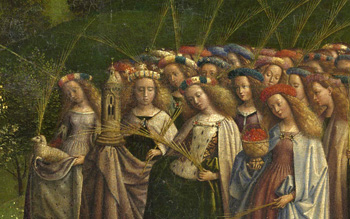
A group of virgin martyrs on the right
All these groups are processing toward the Lamb of God, Our Lord Jesus Christ (Jn 1:29, 36). It is as if the painter is illustrating a phrase from the Apocalypse: The Lamb is the Lord of lords and the King of kings, and those who are with Him are the called and chosen and faithful. (17:14)
Around that Mystical Lamb, Angels kneel in adoration holding the symbols from Christ's Passion: the pillar where Christ was lashed, the nails that were driven through his flesh, the sponge dipped in vinegar. Two Angels swing thuribles, reminding Catholics of a familiar teaching, that the Angels from Heaven ceaselessly honor and adore Christ present in the Holy Eucharist.
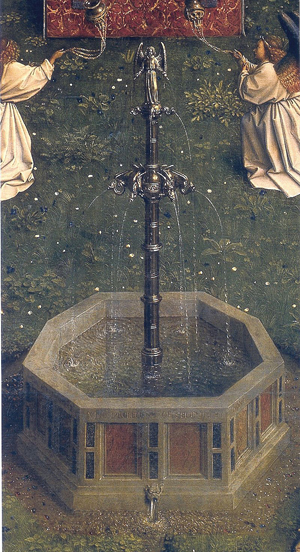
Two Angels swing thuribles above the Fountain of Life, emphasizing the doctrine of the Mass as the source of eternal grace
As we see, everything has a religious meaning, one layer upon another. The dove in the picture symbolizes the Holy Spirit Who sheds His gifts and graces on mankind.
Emphasizing the doctrine of the Mass as the source of eternal grace is the water coming from the Fountain of Life. Crystalline drops flowing from the fountain appear to be falling even outside the painting and onto the viewer.
The message is clear: The Blood of Christ washes away sin and gives us eternal life. A Latin inscription on the altar states: Ecce Agnus Dei qui tollit peccata mundi. "Behold the Lamb of God who takes away the sins of the world" (Jn 1:29). It is, indeed, the Lamb of God who is ever on the altar surrounded by the redeemed who always worship and praise Him.
A final note remains to be said about the remarkable history of the Ghent Altarpiece. In 1566, all hell broke loose in Ghent. Protestant militants broke down the Cathedral doors with an improvised battering ram, intending to burn this grand work of art, which they considered to be an example of Catholic idolatry and excess. But alert Catholic guards had disassembled the enormous work and hidden it in the cathedral tower, where it survived unscathed.
Over the next few centuries, the Ghent Altarpiece was taken as booty in the Napoleonic Wars and then returned to Ghent. Parts of it were stolen by a vicar at St. Bavo and ended up, after several sales, in a Berlin museum. The panels were reunited at the Cathedral as part of the arrangements of the Treaty of Versailles.
Finally, the altarpiece returned to its original home, Saint Bavo Cathedral in Ghent, where it can be viewed today, much of it already restored marvelously in a project that is still ongoing

The inside 12 panels of the Ghent Altarpiece

Posted November --, 2018
______________________
______________________
 Volume I |
 Volume II |
 Volume III |
 Volume IV |
 Volume V |
 Volume VI |
 Volume VII |
 Volume VIII |
 Volume IX |
 Volume XI |
 Special Edition |
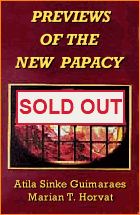 Special Edition |


